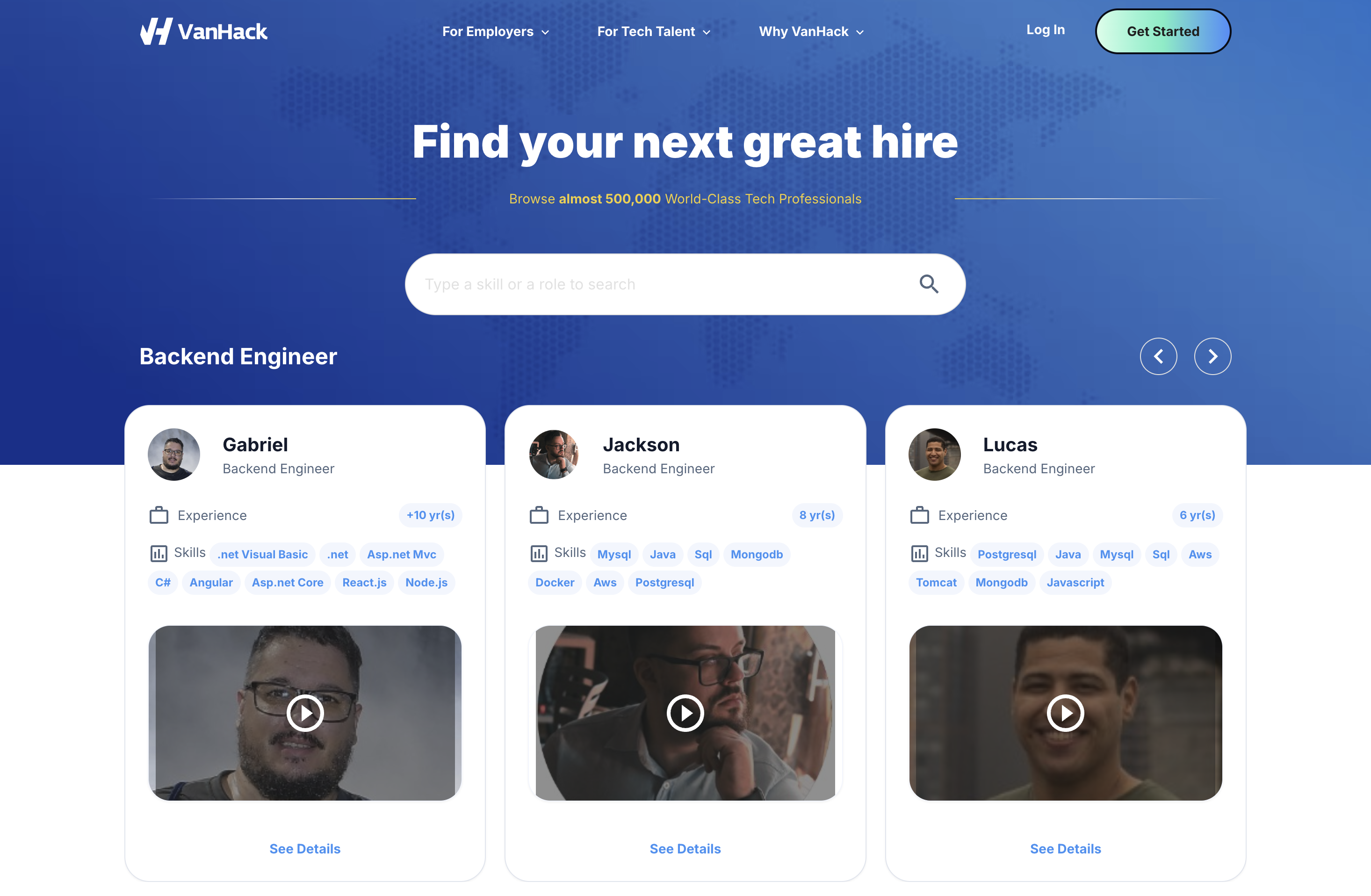The US tech market faces intense challenges. With unemployment for software engineers at historic lows and average salaries above $150,000 per year, finding skilled developers within budget is tough for many companies. Latin America offers a practical alternative, with a growing pool of technical talent ready to fill this gap.
LATAM is home to over 1.5 million software developers. Countries like Brazil, Mexico, and Argentina produce experienced engineers who work in time zones similar to North America, providing a mix of technical skills, cultural compatibility, and cost efficiency that startups and growing businesses need.
This guide covers seven actionable strategies to hire remote LATAM developers effectively. From handling legal requirements to setting up strong vetting processes, you’ll learn how to build a capable engineering team while avoiding common pitfalls.
Looking to grow your talent pool? Connect with pre-vetted LATAM developers through VanHack and see how their platform can speed up your hiring process.
Why LATAM Developers Offer a Strategic Edge for US Firms
Latin America has become a vital source of tech talent as the US struggles with a limited supply of developers. Brazil ranks among the top 10 countries for software development, with over 500,000 active engineers. Mexico adds another 225,000, many with experience working for major global companies.
Time zone alignment is a practical benefit. LATAM developers are typically within 1 to 3 hours of US time zones, allowing for real-time collaboration. This means quicker problem-solving and smoother integration with your team, without the delays often seen with teams in Asia or Eastern Europe.
Cultural similarities also help. Many LATAM developers share comparable business practices and communication styles with US teams. A significant number have studied at well-regarded universities or completed English-taught programs, making cross-border teamwork more effective.
Cost savings are notable too. Hiring in LATAM can reduce total costs by 40 to 60 percent compared to US hires, factoring in recruitment, onboarding, and retention. This allows you to allocate more resources to product growth or team expansion.
Access to experienced talent is another advantage. LATAM offers senior developers with 5 to 10 years of experience in technologies like React, Node.js, Python, and cloud systems, professionals who are increasingly hard to find in the US market.
7 Practical Strategies to Hire Skilled Remote LATAM Developers
1. Build a Strong Employer Brand for International Talent
Your online presence matters when attracting LATAM developers. Unlike local hires who rely on referrals, international candidates often research companies digitally before applying.
Create a culture deck that outlines your company’s values, mission, and growth plans. Highlight professional development opportunities, technical challenges, and the impact developers can have. Stability and clear career paths are especially appealing to LATAM talent.
Share testimonials from current international employees. Short videos of LATAM team members discussing their experiences with onboarding and growth can build trust and help candidates picture themselves in your company.
Optimize your LinkedIn page. Post regular updates about engineering projects, team achievements, and remote work policies. Showcase diversity initiatives and success stories to stand out to global talent.
Set up a dedicated webpage for international hires. Address key concerns like remote work setups, visa support, and career growth opportunities. Clear information about your hiring process builds confidence and draws in better applicants.
2. Write Clear, Globally Friendly Job Descriptions
Job postings for LATAM talent need more detail than US listings. International candidates look for specific information on pay, benefits, and work setups to decide if a role fits.
Be upfront about compensation. List salary ranges in USD to show the role’s value. LATAM developers often compare against US rates, so low offers can deter the best candidates.
Detail your benefits package. Explain health insurance, equipment support, and development budgets, even if managed through a third party. Clarify benefits like flexible hours that might be unfamiliar to international hires.
Avoid US-specific terms like “401(k)” or holiday references. Use universal language and focus on technical challenges, growth paths, and company culture to connect across borders.
Define remote work expectations. State core hours, meeting schedules, and tools used for communication. Specify if the role is fully remote or may involve travel or relocation later.
Outline the job clearly. List main duties, key projects, team setup, and how success is measured. Detailed descriptions help LATAM candidates evaluate fit before applying.
3. Use Specialized Platforms for Faster Talent Sourcing
Standard US job boards like Indeed often fall short for LATAM hiring. They lack features for international needs and can attract unvetted applicants unsuitable for remote roles.
Platforms focused on global tech talent deliver better results. They offer tools to check English skills, time zone fit, and legal work status, making sourcing more efficient.
VanHack’s AI-driven system, Vanna, matches job needs with a pool of over 500,000 global candidates, providing a shortlist of 3 to 5 qualified developers. This cuts down the time spent filtering irrelevant applications.
Their matching goes beyond keywords, analyzing deeper connections between job specs and candidate skills. You get a curated list in days, a major plus in competitive markets.
Want to see this in action? Discover top LATAM talent with VanHack and connect quickly with developers who meet your needs.

4. Set Up Thorough Vetting for Remote Candidates
Resumes alone don’t cut it for evaluating international talent. Distance and cultural differences call for a deeper look at technical abilities, communication, and team fit.
Video introductions give a quick read on English skills and clarity in explaining technical ideas, a must for remote work. This step weeds out candidates with language challenges early.
AI-based technical interviews add depth. VanHack’s system records candidates solving problems, offering videos, transcripts, and scores for each response. Hiring managers can see thought processes and coding skills firsthand.
Tools like Woven provide performance reports on programming skills, reviewed by certified engineers. This consistent scoring cuts bias and helps evaluate candidates fairly.
A multi-faceted vetting approach builds a full picture of each candidate, covering technical know-how, communication, and problem-solving. This saves time before final interviews, especially for senior roles.
Background checks are trickier internationally but vital. Use services familiar with LATAM systems to verify education, past jobs, and references, reducing hiring risks.
5. Manage Legal and Payroll Rules with an Employer of Record
Compliance is a major hurdle in international hiring. US firms must follow local LATAM labor laws, which differ by country, like Brazil’s telework rules or Mexico’s social security requirements.
Misclassifying workers can lead to hefty fines. Missteps in labeling remote LATAM staff as contractors have cost companies millions, including a $2.5 million penalty in Mexico in 2023.
LATAM laws often assume employee status if work terms are unclear. Factors like set hours or company equipment can classify someone as an employee, no matter the contract label.
An Employer of Record (EOR) handles these risks. They manage payroll, taxes, benefits, and compliance with local rules, letting you hire directly without the administrative load.
VanHack offers mobility support as part of their service. Their team helps with visas, immigration, and relocation details like housing, easing the process for both company and candidate.
Contracts need precision. Define roles, pay, benefits, hours, and legal jurisdiction clearly. Regular input from local legal experts keeps you updated on changing laws.
Data privacy adds another layer. Ensure remote staff meet US and local data protection standards, with secure system access and proper handling procedures in place.
6. Craft a Supportive Remote Onboarding Process
Onboarding international hires needs more planning than local programs. Distance, language differences, and cultural gaps can leave new hires feeling disconnected if not addressed.
Assign onboarding buddies. Pair new hires with experienced team members for technical help and cultural insights. This builds connections despite physical separation.
Prepare before day one. Send info on logistics, equipment setup, account access, and first tasks. Include materials on communication styles and meeting norms to ease the transition.
Schedule regular check-ins for the first 90 days. Weekly manager meetings, bi-weekly team sessions, and monthly cultural talks help spot issues early and show support.
Handle tech setup carefully. Confirm internet reliability, provide software licenses, and set up secure access before starting. Account for time zones when planning support calls.
Foster cultural exchange. Arrange virtual coffee chats or cultural sharing sessions to build understanding across the team. These activities strengthen bonds and reduce isolation.
Keep documentation clear. Offer guides on processes, workflows, and communication in simple English. Accessible resources help international hires adapt faster.
7. Focus on Retention Through Growth Opportunities
Hiring great LATAM talent is just the start. Keeping them requires investment in career development and engagement to match what they could find elsewhere.
Set up mentorship. Connect international hires with senior staff for guidance and promotion support. These relationships often grow into valuable professional networks.
Provide learning funds. Offer access to courses, conferences, certifications, or training that align with personal and company goals. This shows a commitment to their future.
Adapt performance reviews. Recognize cultural differences in feedback preferences, adjusting your approach for clarity and fairness across diverse team members.
Ensure career growth. Offer clear promotion paths, leadership programs, and varied projects for remote staff. Rotate roles to build broader skills and experience.
Recognize achievements. Use public praise, written thank-yous, or bonuses to highlight great work. Tailor recognition to cultural norms for maximum impact.
Gather ongoing feedback. Use surveys, exit interviews, and stay conversations to spot retention issues early. Refine your strategies based on this input.
Build broader connections. Support international staff in joining local tech groups or industry networks. This aids their growth and boosts your company’s reputation.
How VanHack Simplifies Hiring Remote LATAM Developers
Implementing the strategies above takes time and expertise many companies don’t have. VanHack provides a solution to navigate the challenges of hiring in LATAM.
|
Feature |
VanHack |
Traditional Agencies |
Job Boards |
|
Talent Pool |
500k+ global talent |
Local/national talent |
Global, but unfiltered |
|
Vetting Level |
Detailed (AI, video, code) |
Basic screening/interviews |
Self-reported only |
|
Time to Shortlist |
Days |
Weeks |
Weeks/Months |
|
Pricing Model |
Flat monthly/success fee |
Percent of annual salary |
Monthly subscription |
VanHack’s Vanna subscription, at $3,000 monthly, grants access to their talent pool and vetting tools for unlimited hires. Some companies have hired multiple developers for a fraction of traditional agency costs.
Their AI system matches job needs with over 500,000 profiles, giving a shortlist of 3 to 5 strong candidates. This saves hours of manual review.
Mobility services set VanHack apart. Their team manages visas, housing, and integration, handling logistics beyond just placement.
Vetting includes video intros, AI interviews, and coding tests for a full view of skills and fit. Hiring managers can assess candidates thoroughly before final steps.
Ready to try it out? Begin hiring with VanHack and see how they can support your recruitment goals.
Common Questions About Hiring LATAM Developers
What Legal Issues Should US Companies Know When Hiring in LATAM?
Compliance with local labor laws is critical, as each LATAM country has unique rules on classification, pay, benefits, and social security. Brazil has specific remote work laws, and Mexico requires social security payments. Misclassification can lead to penalties, so clear contracts defining roles, pay, hours, and jurisdiction are essential. Companies must also handle local taxes and contributions. Laws evolve, so working with local legal experts helps stay compliant.
How Does VanHack Verify the Quality of LATAM Talent?
VanHack uses a multi-step vetting process. Candidates often submit video intros to show English skills and communication style. Their AI system records technical interviews, providing videos, transcripts, and scores on problem-solving and coding. Coding tests from platforms like Woven add detailed performance data, reviewed by experts. This ensures only a few well-matched candidates reach hiring managers, saving time.
Should a LATAM Developer Be Hired as an Employee or Contractor?
Both options exist, but misclassifying workers carries high risks. LATAM laws often default to employee status if work terms seem unclear, focusing on factors like set schedules or company control. Fines can be substantial, as seen in Mexico with a $2.5 million penalty for misclassification. An Employer of Record can manage compliance, payroll, and benefits, reducing risks while ensuring correct classification.
How Does VanHack Support Relocation for Hires?
VanHack’s mobility team handles the full relocation process, including visa processing, flight arrangements, housing, and family needs like schools. Candidates can start remotely during visa waits, maintaining workflow. Post-relocation, hires join local VanHacker community groups for networking. This support reduces administrative burdens for companies and eases transitions for employees.
What Time Zone Benefits Do LATAM Developers Bring?
LATAM developers work within 1 to 3 hours of US time zones, enabling real-time teamwork. They can join daily meetings, address urgent issues, and collaborate on projects without delays common in regions like Asia or Eastern Europe. This alignment supports agile methods, allowing for frequent communication and quick iterations on development tasks.
Tap Into LATAM Talent for Your Next Hire
Latin America’s tech scene offers a valuable opportunity for US firms facing talent shortages and high costs. With over 1.5 million developers, close time zones, and cultural alignment, LATAM is a strong choice for building skilled teams.
Success in hiring here requires more than standard job posts. The seven strategies in this guide, from branding to vetting, lay out a clear path. However, putting them into practice often demands resources many companies lack.
VanHack helps bridge that gap. With AI matching, detailed vetting, and mobility support, they tackle key hiring challenges. Their pricing structure aims to make accessing LATAM talent straightforward.
Hiring LATAM developers offers more than cost benefits. It brings specialized skills, scalability, and diversity that fuel innovation. Companies mastering this approach now will be ready to grow in a global market.
Ready to build your team? Start hiring with VanHack and connect with skilled LATAM developers today.



